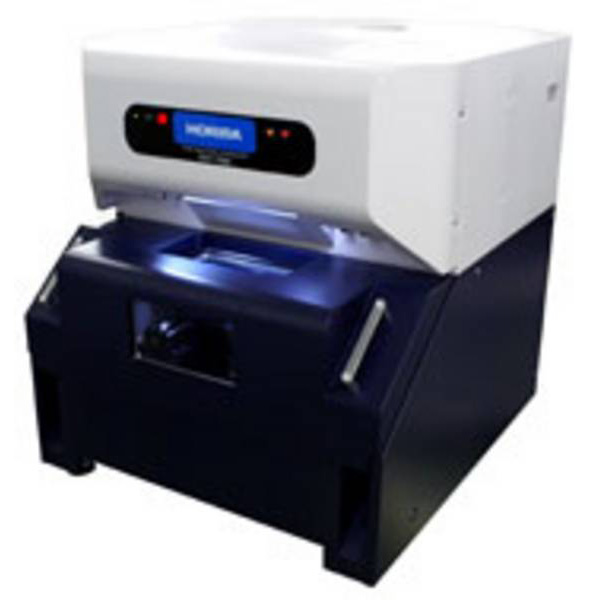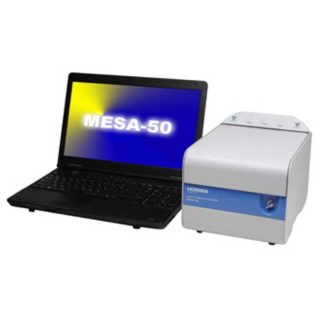XGT-7200
Scientific Product
Assistant Buniness Unit Manager : Miss. Rotsukon Chanseeharat
Tel : 081-988-2819
E-mail : rotsukon@pico.co.th
Admin
Tel : 02-939-5711 ext. 611
E-mail : scientific@pico.co.th
Overview
The XGT-7200 represents a completely new generation of XRF microscope, and leads the way to a new era of science. It offers a seamless merger between optical observation and elemental analysis functions, revolutionizing the world of micro-analysis and establishing micro-XRF as a routine tool for the research and analytical scientist.
Unique hardware features ensure the system offers versatility and flexibility for every measurement. A choice of two software controlled x-ray guide tubes with diameters ranging from a unique 10 µm through to 1.2 mm allow conditions to be optimised for a range of measurements, including both micro and macro. Similarly, with the unique Dual Vacuum Modes it is possible to switch within seconds between a high sensitivity full vacuum mode and a versatile localised vacuum mode. The latter maintains samples at atmospheric pressure whilst retaining sensitivity to all elements from sodium to uranium.
In any configuration the intelligent combination of optical cameras ensure that the precise analysis position can be quickly and simply located.
Single Point and Multi-point Analysis
 Single point and automated multi-point analyses allow high quality spectra to be acquired from either a single position, or from a number of user defined points across the sample. Element peaks are automatically located and labelled, and quantitative analysis down to ppm levels can be carried out using the fundamental parameters method (FPM), FPM with single standard, and full standard sample calibration.Thickness calculations can also be made on nm and µm thick multi-layered structures.
Single point and automated multi-point analyses allow high quality spectra to be acquired from either a single position, or from a number of user defined points across the sample. Element peaks are automatically located and labelled, and quantitative analysis down to ppm levels can be carried out using the fundamental parameters method (FPM), FPM with single standard, and full standard sample calibration.Thickness calculations can also be made on nm and µm thick multi-layered structures.
Hyperspectral Mapping Analysis
 The SmartMap imaging software records a full EDXRF spectrum at each and every pixel of the element image, enabling post-acquisition element image generation and comparison, and spectrum generation from user defined regions in the image with subsequent qualitative and quantitative characterisation.
The SmartMap imaging software records a full EDXRF spectrum at each and every pixel of the element image, enabling post-acquisition element image generation and comparison, and spectrum generation from user defined regions in the image with subsequent qualitative and quantitative characterisation.
Transmitted X-ray imaging provides additional insight into a sample’s structure, allowing features invisible by eye to become immediately apparent.
Features
The unique features of the XGT-7200 have seen this innovative micro-XRF analyser widely embraced for a range of applications, including electronics, engine wear analysis, forensic science, geology, mineralogy, pharmaceutics, museums, metallurgy, biology, medicine and archaeology.
The flexible XGT-7200 micro-XRF system covers everything from macro analysis, for a general survey of a wide area, to the inspection of a specific micro area, with simultaneous XRF and transmission imaging. Its many features ensure high performance analysis with easy operation.
- Highest spatial resolution
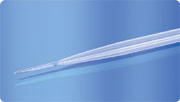 The unique x-ray guide tube technology of HORIBA provides the highest spatial resolution micro-XRF analysis, with x-ray beam diameters down to 10 µm. The high intensity, ultra-narrow beams provided by the guide tubes allow fast, non-destructive analysis of microscopic features.
The unique x-ray guide tube technology of HORIBA provides the highest spatial resolution micro-XRF analysis, with x-ray beam diameters down to 10 µm. The high intensity, ultra-narrow beams provided by the guide tubes allow fast, non-destructive analysis of microscopic features. - Transmission X-ray Mapped Imaging
 In combination with XRF imaging, the XGT-7200 allows transmitted X-ray images to be acquired. This can be used to perform internal structural analyses and identify regions of interest not visible to the eye. Scanning is done with a narrow perpendicular beam, resulting in clear penetrating images even for non-flat samples such as cylindrical parts.
In combination with XRF imaging, the XGT-7200 allows transmitted X-ray images to be acquired. This can be used to perform internal structural analyses and identify regions of interest not visible to the eye. Scanning is done with a narrow perpendicular beam, resulting in clear penetrating images even for non-flat samples such as cylindrical parts. - Dual Vacuum Modes
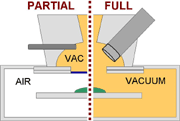 The XGT-7200 system offers the user unique Dual Vacuum Modes for sample analysis – switching between the two modes takes just a few seconds. In Full Vacuum Mode the entire sample chamber is subjected to vacuum conditions to ensure the ultimate sensitivity to light elements. In Partial Vacuum Mode the sample is maintained at atmospheric pressure whilst a vacuum is drawn around the detector and capillary optics. This mode is ideally suited for analysis of water containing samples such as biological tissue, and fragile archaeological/museum objects.
The XGT-7200 system offers the user unique Dual Vacuum Modes for sample analysis – switching between the two modes takes just a few seconds. In Full Vacuum Mode the entire sample chamber is subjected to vacuum conditions to ensure the ultimate sensitivity to light elements. In Partial Vacuum Mode the sample is maintained at atmospheric pressure whilst a vacuum is drawn around the detector and capillary optics. This mode is ideally suited for analysis of water containing samples such as biological tissue, and fragile archaeological/museum objects. - Complete range of sample sizes
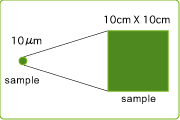 The accommodating sample chamber enables a wide range of samples to be analyzed, from a 10 µm spot analysis on a microscopic feature, to mapped analysis of areas as large as 10cm x 10cm.
The accommodating sample chamber enables a wide range of samples to be analyzed, from a 10 µm spot analysis on a microscopic feature, to mapped analysis of areas as large as 10cm x 10cm. - Integrated Data Acquisition and Analysis Software
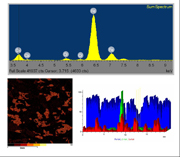 Intuitive software allows easy control of instrument hardware, fast sample visualization and selection of measurement region, and full data analysis. Functions include automated peak identification, quantitative measurements, RGB composite image generation, line profile analysis.
Intuitive software allows easy control of instrument hardware, fast sample visualization and selection of measurement region, and full data analysis. Functions include automated peak identification, quantitative measurements, RGB composite image generation, line profile analysis.

